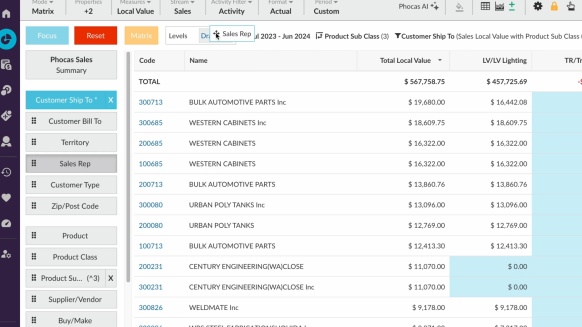7 KPIs and metrics for highly effective sales managers

Sales managers need to be savvy and strategic to get ahead. Fortunately, there are many advanced financial planning and analytics solutions available to help motivate your team and drive performance. Through FP&A and BI software, sales managers can gain insight into the sales process and manage an effective and efficient team. But are you measuring the right key performance indicators? Here are 7 effective sales team metrics to get you started or compare against what you're currently doing to check in on your sales efforts.
FP&A and BI solutions have revolutionized sales measurement. The data these platforms can consolidate and analyze enables sales managers to pinpoint sales cycle length, sales activities that generate leads, customer acquisition cost (CAC) and importantly have a fair and accurate way to measure sales performance of the whole team and individual’s sales goals.
Easy-to-understand dashboards with real-time results help sales leaders track sales and benchmark important kpis, cross-sell and upsell to existing customers and define customer profitability. There is great potential for sales managers to use total sales data to nurture high performing salespeople. Sales reps can also share results with the marketing team and work collaboratively with them to generate new leads and new customers.
So, are you measuring the necessary sales metrics to ensure your sales team is implementing the most effective sales strategies? We outline the 7 sales team metrics every sales manager should measure.
1. The sales pipeline
The value of a sales pipeline is an alternative way to gauge a company’s health. Sometimes presented in a graphical format, it shows the total number of sales opportunities the company currently has and an estimation of the amount of revenue the sales team is going to generate in the coming months. If the opportunities within the pipeline are managed well, the sales team will stay organized and feel more in control of their sales targets, giving the sales manager more confidence in the team’s ability to make closed deals.
What sales KPIs should be measured in a sales team’s pipeline?
- Number of potential deals in your pipeline
- Average purchase value or deal size (in $) in your pipeline
- Lead conversion or the average number of deals that are converted from leads to customers
- Average time deals are in the pipeline (measured in days)
Win probability: Number of Deals Won / Total Number of Deals) × 100 at each pipeline stage.
2. Sales revenue
Measuring the revenue a sales team brings in, instead of only their profit margin, gives a sales manager more insight into the business' performance. If a company experiences steady ‘top-line growth’, it could be viewed that the performance in that period was positive even if the earnings growth or ‘bottom-line growth’ didn’t change.
Measuring revenue allows you to identify the profitability of the business. By calculating the profit ratio (divide net income by sales revenue) businesses can reveal how much of every dollar brought in by sales actually makes it to the bottom line. If your business is subscription-based or saas company measuring monthly recurring revenue (mrr) or annual recurring revenue (arr) to provide a measure of the revenue that a business can reliably expect to generate each month or year.
Average revenue per customer = Total Revenue / Number of customers
3. Forecast accuracy
Forecasts will never be exact, but there are FP&A and BI tools available that assist business people with sales forecasting. The accuracy of forecasting depends on the quality of the sales data as well as the ability to measure sales forecast with actual sales on an ongoing basis. This ensures your team is continually reaching its predicted targets or at least getting closer to them as time goes on. Producing accurate forecasts enables a company to reveal issues threatening the business like poor customer satisfaction as well as be able to cease new opportunities that arise to increase the customer base.
4. Sales funnel leakage
No sales team wants a leaky funnel but sometimes with limited technology and resources, this can happen. It’s imperative to know where the holes in your funnel are, how they occurred, and how you can essentially ‘plug’ them. Things to review include:
- Lead response time: a business that responds quickly to a sales qualified lead is more likely to win the sale
Average response time = Total amount of time to respond to leads ÷ total number of leads
- Quality of follow up contact: the right fit is key, a sales team should follow up with a lead via phone calls and ask pertinent questions to determine if the prospect is qualified
By constantly monitoring this data and putting a system in place to avoid opportunity leakage, the overall sales numbers will improve.
5. Cross-sell and upsell opportunities
Cross-selling and upselling can be complex and risky. However, with the challenges around new customer acquisition, businesses must find ways to improve sales from existing customers. With the right FP& A and BI tool, businesses can identify cross-selling and upselling opportunities in the organisation and ultimately, generate sales growth for the business.
Upsell rate % = Upsell revenue ÷ total revenue
Cross sell rate % = Cross-selling revenue ÷ total revenue
6. Conversion rate aka “win rate”
It’s important to be aware of how many leads or opportunities are being converted into customers. The conversion rate metric focuses on the final stage of a sales team’s pipeline. By this point, a sales team would have invested a lot of time and resources into the lead so this rate should be as high as possible.
A low or constantly changing closure rate signifies a lack of competitiveness in the market, which means the value proposition being offered to the leads is not strong or convincing. It may also mean that the sales team requires additional training or sales script templates to assist them during sales calls.
Measuring a sales team’s performance has evolved from the simple spreadsheets to tracking the right sales kpis that are fair and motivational for all sales representatives . There are now advanced business intelligence software options that provide dynamic reporting capabilities with dashboards to help automatically track business KPIs and key metrics. This gives a sales manager the ability to become more proactive as well as make more insightful and strategic decisions that will benefit the company.
7. Customer satisfaction
Understanding current customer problems can be very helpful in selling to new customers because they provide insights into how other similar people are thinking or behaving. Customer retention and customer churn rates are two opposite but important measures that make up the challenging task of customer relationship management (crm).
Customer retention rate is the percentage of customers who continue buying your products. The metric measures your sales team’s ability to support recurring sales.
Churn rates on the other hand reflect the percentage of customers who don’t buy again. This metric can signal problems with your product or offer; it can also indicate competition for new customers in your category.
Another telling metric about customers is customer lifetime value (LTV), this estimates the total revenue a company expects from a single customer account throughout their relationship.
LTV = Average Purchase Value × Purchase Frequency × Customer Lifespan
Churn Rate = (Number of Customers at Start of Period – Number of Customers at End of Period) / Number of Customers at Start of Period × 100
Sales key performance indicators (KPIs) are crucial for steering sales teams toward success. By thoughtfully selecting and monitoring these KPIs, businesses can identify effective strategies, improve alignment in their sales approaches and increase revenue. The key is to choose the right metrics to suit your business and industry, leverage FP&A and BI technology for tracking KPIs and make data-driven decisions. This enables sales teams to achieve their targets more efficiently and contribute to the company's business goals.

Empowering businesses with intuitive data analytics, driving informed decisions for growth and profitability. We make people feel good about data.

The best financial KPIs for the distribution industry
Finance professionals in distribution businesses face a persistent challenge. That is to effectively blend operational and financial data to gain a complete picture of company performance. Traditional financial ratios often exist in isolation, making it difficult to assess the broader impact of operational decisions on financial outcomes.
Read more
Key sales KPIs for distribution companies
Managing sales in a distribution business without measuring key performance indicators (KPIs) is like maintaining your home without tools or a schedule. You don’t notice a leak until the damage is severe. Instead of making progress, you waste time searching for the right tools or calling an expert for simple fixes. Without the right KPIs, inefficiencies can go unnoticed, leading to cashflow issues and lost sales.
Read more
5 key FP&A trends for 2025
The role of the CFO is evolving rapidly, extending beyond traditional financial stewardship to encompass business partnering, operational oversight and technological innovation. A 2024 Sage study of over 1,200 global finance leaders reinforces this transformation:
Read more
The wide appeal of self-service reporting
Your own data is a critical asset that can drive business growth, improve decision-making, and boost customer satisfaction. Among the various tools available, self-service reporting solves one of the most significant barriers to real-time data analysis—accessibility.
Read more
Find out how our platform gives you the visibility you need to get more done.
Get your demo today
